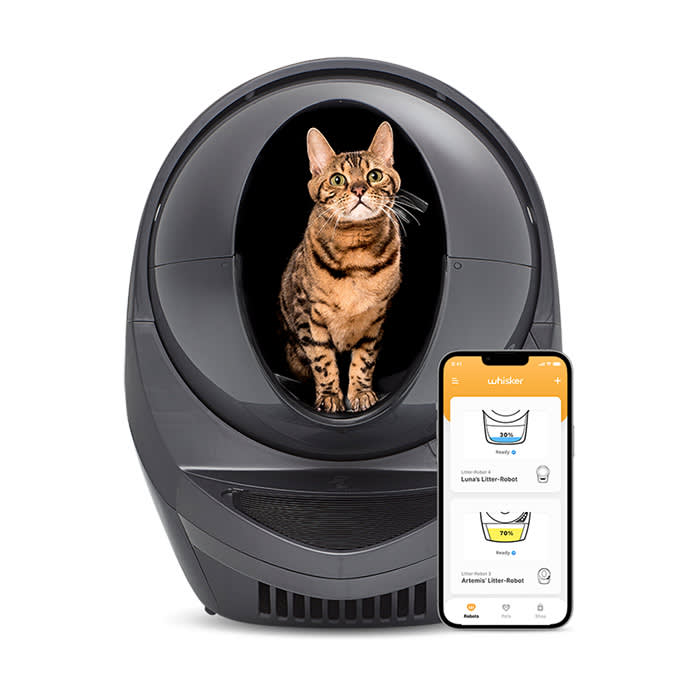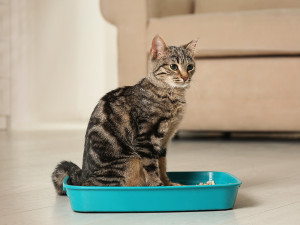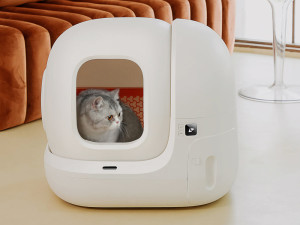Litter Robot: Will My Cat Use an Automatic Litter Box?
I introduced my cat to an automatic litter box, and let’s just say it went off with... multiple hitches

Share Article
In this article:
What are automatic litter boxesopens in a new tab Litter robot reviewopens in a new tab Automatic litter box benefitsopens in a new tab Automatic litter box drawbacksopens in a new tab Who is this product for?opens in a new tab
For some cat parents, an automatic litter box can be a lifesaver, especially if you have a demanding job or spend a lot of time away from home – or if you just don’t want to clean up cat poo and pee all the time.

Get (totally free) deals for food, treats, accessories, tech and way more pet parenting must-haves.
What is an automatic litter box?
An automatic litter box for cats does the hard work of cleaning and sifting litter for you. After your cat does their business, the box automatically sifts, flushes, or collects the waste, ensuring that you have minimal contact with your cat’s urine and faeces. Say goodbye to scooping out your cat’s waste each day (or multiple times a day if you have more than one cat in the house). Instead, you only have to remove the bag and replace it with a new liner and refill litter when needed.
Litter robot review
The Litter Robot by Whiskeropens in a new tab is a smart device with a sleek design that connects to Wi-Fi, allowing you to use the company’s app to monitor the litter and waste levels. Litter Robot customer reviews note the box’s light plastic construction, which makes it easy to move, as well as the simplicity of set-up. Of course, with any smart technology, there’s always the potential of pairing issues, which may require a call to customer service.
But when the device is properly set up and running, it can do more than keep your cat’s litter box clean. The Litter Robot also features weight sensors to monitor how often your cat uses the box, which can be an early sign of feline healthopens in a new tab issues.
Trying the automatic litter box
I’d seen automatic litter boxes before, but they were all so ugly and seemed like they would be a nightmare to clean. Also, they’re expensive, and I just couldn’t imagine spending that much money on something my cat poos in. And yet, the idea of not having to scoop the litter box every time I entered the bathroom was very appealing.
“Typically, I am not a fan of automatic litter boxes – some cats do well with them, but many are afraid of them, and it can be a difficult transition,” cat behaviourist and Kinship Collective member Cristin Tamburoopens in a new tab says. She adds that, even though the boxes themselves are large, the place where cats actually go is small and not ideal.
She says she’s only recommended an automatic litter box once. “It was one of those rare cases where the cat would not use the box if it had any ‘deposits’ in it. It had to be pristine, or the cat would go somewhere else in the home. Obviously, the cat’s parents couldn’t be home to scoop the box after every use, so we implemented an automatic litter box, and it actually did the trick!”
Of course, having already decided that I wanted to try an automatic litter box, all I took from Tamburo’s story were four words: “it did the trick!”
So, being an all-or-nothing kind of person (and a bit bougie), I got my hands on the fanciest automatic litter box I could find: the Litter Robot 3 Connect by Whiskeropens in a new tab. At £599, it’s pretty much the Mercedes-Benz of automatic litter boxes, as many reviews for the Litter Robot will tell you. I set it up beside Pumpkin‘s existing litter box and let him sniff it out and get used to it for a few days before I plugged it in.
Then, I watched him watch it run through a cleaning cycle. So far, so good. Pumpkin wasn’t scared of it, but he didn’t seem particularly keen on giving it a try either. I put a little of his old litter inside the chamber and even sprayed the machine with catnip to try to entice him. Finally, I stopped cleaning his old litter box, hoping that this would compel him to at least try our new high-tech toy.
Not for my cat, but maybe for yours
For two and a half days, he fouled his litter crate until the whole thing was just one big urine clump dotted with turds. I kept him out of my room for the sake of my mattress, but I was starting to miss our naptime cuddles, so, on the afternoon of the third day, I decided it was time to end our little experiment. Also, watching him climb into his overflowing litter box 10 times a day (he goes to the toilet a lot) was breaking my heart. I was too late, though. When I got home from running errands, Pumpkin was sitting on the couch beside a wee stain the size of a large pizza. F**k. I took out the vinegar and spent the next two hours cleaning the couch before replacing the litter opens in a new tabin Pumpkin’s original box.
Just because the Litter Robot didn’t work for Pumpkin doesn’t mean it couldn’t work for someone else. A representative from the company told me that 96 percent of cats who try the Litter Robot successfully transition and end up using it exclusively. So, I gifted it to a friend with two cats of her own, who not only love peeing in it, but also playing in it. My friend is pretty happy with it, too – there is zero smell, and she only needs to clean out the poo trap once every week or two.
“To ensure a cat will use the litter box (any box), it should be as comfortable and easy for them to use as possible,” Tamburo says. “In my opinion, bigger is always better when it comes to litter boxes. Ideally, they should be at least one and a half times the size of the cat, and your cat should be able to easily manoeuvre and turn around without having to play Twister.”
Some thoughts to keep in mind
Looking back, I probably shouldn’t have messed with Pumpkin’s litter situation to begin with. He’s 16 years old, and even if he had taken to the Litter Robot, he has medical issues that require him to wear a cone from time to time, which would have made manoeuvring inside the egg-shaped chamber difficult, if not impossible.
Tamburo adds that most cats prefer open boxes without lids. “And many cats can be quite particular about litter depth and litter type, so the fact that a lot of automatic boxes are only compatible with certain types of litter is problematic. The noises and movements made when the boxes self-clean can also startle many cats. If a cat gets startled or has a bad experience in whatever type of litter box they’re using, it can lead to litter box aversion, causing them to start going outside the box.”
“Additionally, a cat’s bathroom habits can tell us a lot about their overall health,” Tamburo says. “Being able to monitor their ‘outputs’ via daily scooping is a good way to keep an eye on your cat’s health. While some of the boxes do have apps that help with some sense of monitoring, it’s not quite the same. Lastly, while automatic boxes can be less work on a daily basis, they still require maintenance and can be even more difficult to clean – especially if your cat has GI issues.”
Still, if, like me, you really want to give it a shot, Tamburo has some pro tips: “Anything we do with cats should be done in small, incremental steps – at a pace that a cat is comfortable with. Moving too quickly or forcing anything on a cat generally backfires. The box should be as close to the current litter box location as possible, and you should leave it there for as long as it takes for your cat to adjust to the automatic box. When possible, use the same type of litter. And every time you see your cat using the new, automatic box, the behaviour should be rewarded with treats, praise, pets, or whatever your particular cat finds rewarding.”
Of course, if your cat really doesn’t take to it, one of the good things about Litter Robot in particular is that you can return it within 90 days for a full refund. Because, look, some cats, like my friend’s, love it. Others, not so much. And anyone who has a cat knows there is no convincing them to do something they simply do not want to do. Even if it would make your life so much easier.
What to consider when transitioning your cat to an automatic litter box
Some cats can be frightened of the noises an automatic litter box makes when cleaning, so you may want to leave the device unplugged for a few days to give your cat time to adjust. Continue to keep a traditional litter box nearby so your cat has that option as well if the automatic box proves too daunting.
As with any new device, there’s definitely a transition period – not just for your cat but for you too. While you won’t clean the litter box every day, Litter Robot reviews warn that you’ll still have to monitor the litter and troubleshoot any tech issues that come up with the device.
The benefits of using an automatic litter box
While these devices aren’t right for every cat – or every home – the pros of an automatic litter box easily outnumber the negatives. Obviously, the biggest pro for any cat parent is the reduced time you have to spend cleaning up your cat’s waste. If your household has more than one cat, an automatic litter box can be super helpful, especially if you have a busy lifestyle and need to eliminate a chore from your to-do list.
Perhaps best of all, automatic litter boxes are designed to mask odours, so you don’t have to keep stocking up on air freshener to keep your house from smelling. And many units, including the Litter Robot, connect to a mobile app that lets you know when the waste bin needs emptying or litter is running low.
The drawbacks of using an automatic litter box
Any new technology has the potential for issues, whether setting up the device or dealing with sensors or other elements failing to work properly. An automatic litter box is no different, and it can quickly become more of a hassle than a time-saver if the device doesn’t clean itself fully. One of the major cons of an automatic litter box is that many cats are startled or afraid of the noises the device makes. Some cats may become used to the device, while others may never adapt to using it.
Who should buy the Litter Robot?
An automatic litter box is ideal for cat parents who work long hours or those with an illness or disability that makes cleaning up after their pet a challenge. The Litter Robot can also be a great option for multi-cat households because it requires less frequent clean-up.
Frequently asked questions
Can I use the Litter Robot with multiple cats?
The latest iteration of the device, the Litter Robot 4,opens in a new tab is cleared for up to four cats. Just keep in mind that, the more cats who use the litter box, the more often you will have to empty the waste receptacle.
How often do I need to clean the Litter Robot?
The Litter Robot will notify you when the waste drawer needs to be emptied out and when you should add more litter, so always do these tasks ASAP to keep the device clean for your cat. Plan to wipe down the entire litter box once a month and perform a more thorough cleaning once a year.
What do I do if I encounter technical issues with my Litter Robot?
For technical issues with the Litter Robot, you can review Whisker’s online troubleshooting guidesopens in a new tab or contact customer service.
Is there a warranty for the Litter Robot?
The Litter Robot comes with a one-year warranty, and you can add on an additional three years of coverage for an extra fee. The warranty covers any repairs to the device at no charge, including free shipping.

Charles Manning
Charles Manning is an actor, writer, and fashion/media consultant living in New York City with his two cats, Pumpkin and Bear. Follow him on Instagram @charlesemanningopens in a new tab.
Related articles
![Cat sitting in a teal litter box]() opens in a new tab
opens in a new tabMastering the Art of Litter Box Training: How to Train Cats to Use a Litter Box
If you do nothing else, teach your cat to poo in their litter box (and not in your shoe)
![Maine coon cat using the litter box.]() opens in a new tab
opens in a new tabUncovered Secrets: Why Cats Don’t Always Cover Their Poo
And how you can encourage them to cover up after doing their business
![]() opens in a new tab
opens in a new tab5 Litter Box Enclosures That Aren’t Total Eyesores
Keep your cat’s litter box out of sight – but easy to clean
![cat in white electronic litter box]() opens in a new tab
opens in a new tabFinally, a Litter Box That’s Thought of Everything
An electric litter box for techy cat parents and their tactful felines





